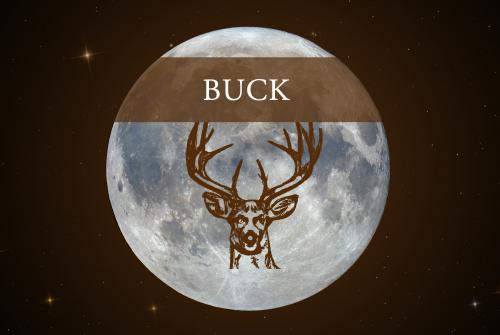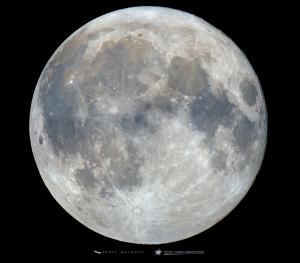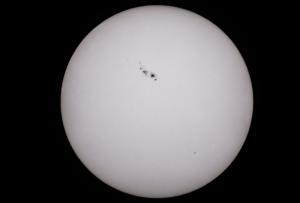Celebration of Space - June 30, 2023
This coming Monday, July 3, 2023 at 7:41 am, the Moon will arrive at the point in its orbit where the side we see ends up in full sunlight. This will only happen when the Moon arrives at opposition, which is when the Moon is on the opposite side of Earth than the Sun. This all sounds really geeky and important, but take all that away and it is just the full Moon. In July, the full Moon carries the moniker The Full Buck Moon, which is related to the antlers that male deer grow during July. Other names for the July Moon are The Salmon Moon, The Raspberry Moon, The Thunder Moon, and the Berry Moon.
Many outlets are calling the July Moon a Supermoon, which is when the full lunar phase occurs alongside lunar perigee (when the Moon is at its closest approach to Earth in its 27.3 day orbit). But the July lunar perigee will occur on July 4, 2023 at 7:29 pm, which is about 36 hours after the full phase occurs. At Frosty Drew, we would not consider this a perigee-syzygy, which is the geeky way of saying supermoon. Regardless, be sure to step outside around 9:30 pm Monday night, and look to the SE horizon to catch a view of the Full Buck Moon of July rising, and watch out for deer crossing the road when driving home.
Earlier this week a stunning sunspot group started to appear on the Sun, and quickly evolved into a huge group of large sunspots that are currently 10 times the diameter of Earth. This sunspot group is designated AR3354, and has been reported as larger than the Carrington Sunspot, which triggered the infamous Carrington Event. Though quite large and nothing short of awesome, it doesn’t mean that we will have another Carrington level geomagnetic storm.
The Carrington Event happened in September 1859, which was during Solar Cycle 10 (we are currently in Solar Cycle 25), and was a large Coronal Mass Ejection (CME) that was Earth facing. When the CME arrived at Earth, the geomagnetic storm was so strong that communication equipment experienced failures, with some allegations of telegraph stations catching fire due to the sparks that the geomagnetic storm created along communication lines. The Aurora Borealis was reported as visible globally. This event has become the de facto goto for doomsayers as evidence that OMG! the Sun will kill us all! Thankfully, events like the Carrington Event, though dangerous for power stations and Facebook connectivity, will not wipe out civilization as we know it. But let’s first understand what a CME is.
A Coronal Mass Ejection will occur when a sunspot group on the Sun breaks up. Sunspots form due to solar material that rises from the inner layers of the Sun, called granules, which carry energy to the solar photosphere, turn over, and release their energy before sinking back down. The Sun is a plasma, which means that granules will be magnetic in a dipolar configuration (N and S pole). When many granules rise in the same area, they may become magnetically connected to each other and remain on the solar photosphere. This connection will form a magnetic field over the connected granules allowing them to cool. This is a sunspot. Eventually granules under the sunspot will start to push through and the magnetic field will break open. When this happens, a large amount of energy is blasted off the photosphere, it is plasma, so it will create a magnetic push on the upper atmospheres of the Sun, notably the solar corona, and allow for a much higher density of plasma in the corona to be released into the solar wind (a constant outflow of energy from the Sun). This is a CME. If the CME occurred on the side of the Sun that is facing Earth, our magnetic field will be bombarded by the CME in 2-3 days time.
Now just because a sunspot group is as big (or bigger) than the Carrington Sunspot, which was the trigger for the CME that created the Carrington Event, doesn’t mean that it will produce a CME that was comparable to the Carrington CME. Additionally, it is not uncommon to have a sunspot group grow to this size during the active side of the 11 year solar cycle, which we call Solar Maximum. If you’re the type that gets a bit of anxiety about space events, then you should know that the likely scenario of having a sunspot group this size will be fantastic views of the sunspot, which can be seen with those eclipse glasses you may have sitting around from the 2017 solar eclipse. Perhaps even some fabulous views of the Northern Lights for those who live in more northern and southern latitudes. But OMG we’re all going to die! Probably not..
Check out this stunning image of Sunspot Group AR3354 captured by Frosty Drew Astronomy Team member, Ron Zincone
On June 25, 2023, the James Webb Space Telescope (JWST) turned its huge mirror towards Saturn, and started to snap away. The result was the first photo of the ringed planet from the JWST, and the photo is in infrared wavelengths. Saturn appears quite dark in the infrared, but the rings shine brightly. In the image some of Saturn’s 83 moons are visible, but what is the most striking is the ring groups that are visible (C-F). Now that Saturn is approaching the Autumnal Equinox, which will occur on May 6, 2025, our view of the rings is starting to become quite thin. Check out the image of Saturn from the JWST, then gear up for awesome views of Saturn at Frosty Drew in the big 24 inch telescope later this summer and autumn.
Have a fantastic Independence Day from all the astro-geeks at Frosty Drew Observatory and Science Center!
- Author:
- Scott MacNeill
- Entry Date:
- Jun 30, 2023
- Published Under:
- Scott MacNeill's Columns




